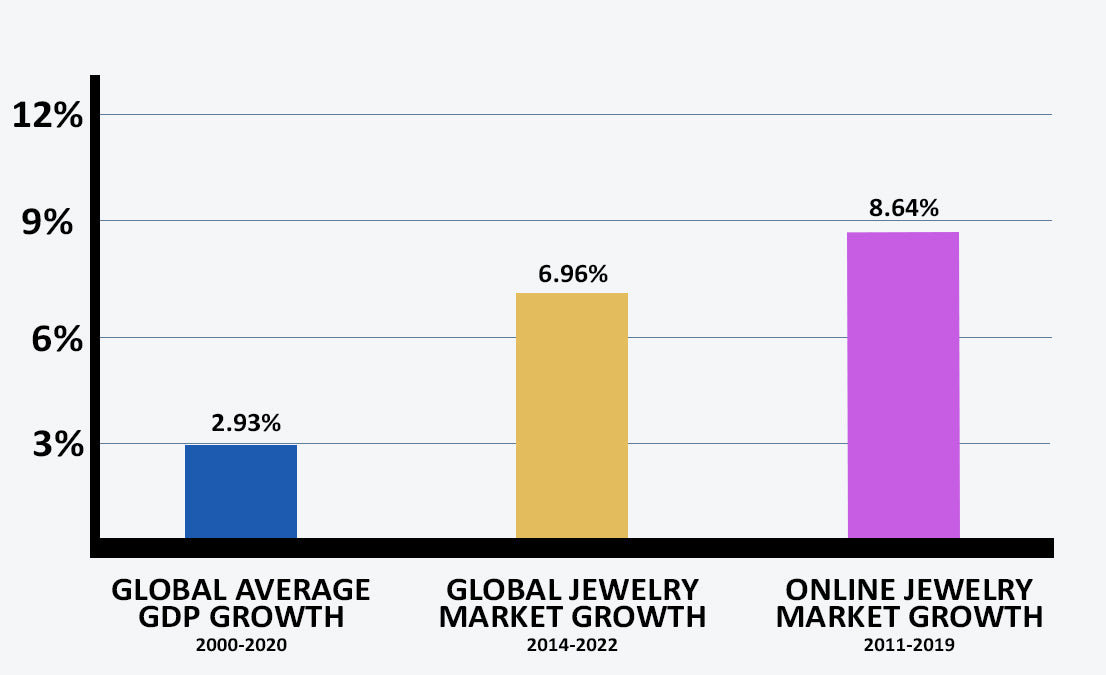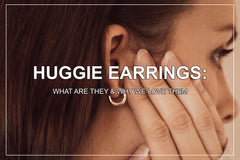
Jewelry is one of the pillars of the current fashion industry.
Although people have worn jewelry as an accessory for millenniums, it continues to be one of the hottest and most loved categories in fashion worldwide.
With options ranging from some of the most beautiful and expensive designs to the world of fast fashion, filled with cheap and next to disposable items, the immense scale of the jewelry market today is unsurprising.
Let's take a deep dive into the current jewelry market statistics and discover the answers to the most relevant questions regarding jewelry demographics and shopping behavior.
In this statistics roundup, you'll learn:
Jewelry statistics (editors picks)
- Jewelry market size: The global jewelry market is currently valued at $340 billion.
- Online jewelry market size: The total online jewelry market is currently valued at $57 billion.
- United States market size: The US jewelry market is currently valued at $69 billion. That's 20% of the total global jewelry market.
- Europe market size: The European jewelry market is currently valued at $34.7 billion (32.2€ billion).
- Jewelry market CAGR: Looking at the data between 2014-2022, the jewelry market grows 6.96% annually.
- Online jewelry market CAGR: From 2011-2019, the online jewelry market grew at an average of 8.64% annually. From 2020-2027 it is expected to grow at a compound annual growth rate of 19.56%.
- Most active shoppers: Married 25-34-year-old women with an average salary buy the most jewelry.
- Biggest spenders: High-income people in the age group 45-54 spend the most money on jewelry, consuming $304.6 worth of jewelry every year.
- Average American consumer: When it comes to shopping habits in the United States, the average American spends a modest $78.14 on jewelry each year.
- Best-selling jewelry: While necklaces are the best-performing jewelry category globally, women prefer earrings over other jewelry.
- Average cost: Data from 117 different jewelers shows the average retail price for jewelry is $804.
- Markup: 2020 & 2021 data from two of the largest jewelry businesses in the world (Signet Jewelers and Tiffany & Co) shows that the average markup on jewelry is 116%. That's 2.16 times the original acquisition + possible marketing cost of jewelry.
- Most searched: Looking at data between 2017-2022, the most searched jewelry category is rings, with engagement rings being the most popular ring-related search on Google.
Jewelry market size
How big is the jewelry market?
According to Grand View Research, the global jewelry market value in 2023 is USD 340.69 billion. This number is based on 2022 end data.

- For comparison, in 2014, the global jewelry market was valued at USD 157 billion.
- During the past nine years, the jewelry market value has grown by $183 billion, more than doubling in size.
In fact, these figures have made jewelry one of the fastest-growing segments in fashion during the past five years.
Let's decode these numbers.
How about the online jewelry market?
With eCommerce sales contributing $57.4 billion, approximately 16.7% of all jewelry sales are made online.

For comparison, in 2021, online sales represented roughly 8.1% of global jewelry sales. This means that the transition from brick-and-mortar stores to eCommerce has been prevalent during the past few years.
Since eCommerce accounts for 20.8% of all retail sales, the jewelry market has experienced a slightly slower transition online than the average product.
The global online jewelry market is forecast to reach $117.3 billion in size by 2027. This means that online jewelry is expected to see a compound annual growth rate of 19.56%.
Which country spends the most on jewelry?
With an expenditure of USD 111.5 billion, China buys, produces, and consumes the most jewelry.
| Country | Jewelry Market Value (USD) | % Of Total Jewelry Market |
|---|---|---|
| 1. China | $141.1 billion | 41.5% |
| 2. United States | $69.15 billion | 20% |
| 3. India | $51.44 billion | 15% |
| 4. Hong Kong | $12.29 billion | 3.6% |
| 5. Japan | $11.96 billion | 3.5% |
| 6. Russian Federation | $10.88 billion | 3.2% |
| 7. Turkey | $9.52 billion | 2.8% |
| 8. Canada | $8.92 billion | 2.5% |
| 9. Germany | $6.78 billion | 2% |
| 10. United Kingdom | $6.63 billion | 1.95% |
The United States valued at $69.1 billion, is the second biggest jewelry market in the world, while India is the third-largest jewelry market with $51.4 billion.
How big is the jewelry market in the US?
The jewelry market in the United States is currently valued at $69 billion.
- It is the second-largest country by jewelry market value, only shadowed by the gigantic $141.1 billion jewelry market in China.
- The US jewelry market is currently 51.1% smaller than the jewelry market in China.
- However, the US Jewelry market is over twice (111%) the size of the jewelry market of Europe.
The online jewelry market in the United States is valued at $9.8 billion, meaning that 14.2% of all jewelry sales in the US happen online.
Although the United States jewelry market is only 20% of the global jewelry market value, 38.18% of all online sales worldwide take place in the US.
What about the jewelry market value in Europe?
According to Statista, the current European jewelry segment market is valued at US$34.73 billion (EUR 32.2 billion).
- This number is reported as a 7.1% increase from the previous year when Europe generated US$32.42 billion (EUR 30.06 billion) in jewelry segment revenue.
- 27% of the jewelry market in Europe comes from the luxury goods market, while the remaining 73% is from non-luxury goods.
What is the jewelry market growth rate?
Based on the market data from 2014-2022, the current compound annual growth rate (CAGR) of the global jewelry market is 6.96%.

The estimated growth rates for the global jewelry market range from 3.1-8.5%, giving us the average estimated annual growth expectation of 5.8% CAGR from 2022-2030.
- Online jewelry market, on the other hand, has experienced an annual average growth of 8.64% during 2011-2019. It is is expected to grow at a compound annual growth rate of 19.56% until 2027.
Sources: GrandViewResearch, FashionUnited, Statista 1, Statista 2, Statista 3, Statista 4, DigitalCommerce360, Oberlo, RichDiamonds, WorldStopExports, WorldBank
Key jewelry market demographics
Who buys the most jewelry?
As stated in the jewelry market research from GWI, married average-income women between the ages 25-34 buy the most jewelry, while 45-54-year-old people with an annual income of $200,000 spend the most money on jewelry.

- 44% of men have bought jewelry during their lives, in comparison to 56% of women.
- As for marital status, 55% of all jewelry purchases were made by married people. Single people accounted for 30%, and people in a relationship only 12% of jewelry expenditure globally.
- 22% of all jewelry buyers are between 35-44 years old, while merely 4% buy jewelry after the age of 55.

When it comes to countries with the most generated jewelry revenue in relation to population size, Hong Kong is the clear jewelry hub of the world with a whopping US$1288.4 annual jewelry revenue generated per capita.
| Country | Annual Jewelry Revenue Generated Per Capita (USD) |
|---|---|
| 1. Hong Kong | $1288.4 |
| 2. Singapore | $439.6 |
| 3. United States | $187.4 |
| 4. Canada | $173.3 |
| 5. Australia | $142.07 |
| 6. Turkey | $90.4 |
| 7. Italy | $84.9 |
| 8. China | $79.6 |
| 9. United Kingdom | $78.99 |
| 10. Republic of Korea | $77.2 |
What age group buys the most jewelry?
When it comes to age demographics, 45-54 age group spends the most on jewelry with an average annual spend of US$304.6 per consumer.
Annual Jewelry Spend
As for total jewelry expenditure by age group, people between the ages 25-34 are the busiest jewelry shoppers, contributing 35% of all jewelry sales globally.
The second-largest age group is the youth (16-24-year-olds), making up 27% of total jewelry expenditure.

- Interestingly, young people between the ages of 16 and 34 make up 62% of all jewelry buyers.
- In contrast, the older half of the population (aged 45 and above) only make up 16% of global jewelry shoppers.
Average American jewelry expenditure annually
According to the data collected between 2018-2020, the average American spends $78.14 on jewelry every year, while the average American household spends a whopping $434.3 on jewelry purchases annually.

- In 2020, the average American spent 35% less on jewelry than during the previous year.
- During the four-year period of 2016-2020, the American household jewelry expenditure rose a total of 15.3%.
- According to the data by Trading Economics, Americans earn $27.07 in wage/hour. This means that the average American buys 2.9 working hours worth of jewelry every year.
How much do millennials spend on jewelry?
Based on the data from the United States, the average millennial spends $203 on jewelry annually.
- In the US, the average millennial spends 157.9% more on jewelry than the average American.
- Although millennials account for 23% of the total world population, they make up 57% of all jewelry expenditure globally.
What age group wears the most jewelry?
When it comes to wearing jewelry, the youth and young adults are the most enthusiastic.
The numbers confirm the popularity of jewelry among young adults, as the 16-44 age group constitutes 82% of all jewelry purchases in the world.
This doesn't necessarily mean that elderly folks don't like to wear jewelry. Perhaps they simply have purchased their favorite jewelry pieces already and are now mainly focused on wearing their prized possessions.
Sources: GWI, Statista 1, Statista 2, EdahnGolan, TradingEconomics, WorldEconomicForum
Most popular jewelry types
What type of jewelry sells the most?
According to the research, women are most inclined to buy earrings, while men like necklaces the most. When considering the whole population, necklaces are the top-selling jewelry category.

- 87% of women say they wear earrings regularly, while 64% wear a necklace, and 47% a bracelet daily.
- Surprisingly, only approximately half of all women (53%) wear rings on a daily basis.
What is the most popular jewelry today?
When looking at the broad jewelry categories, necklaces are the most popular jewelry today.
According to a 2019 study based on 1003 respondents in France, rings were the most worn jewelry type (60%) with necklaces (57%) coming in a close second.
Here is some detailed data about jewelry popularity by category;
- Necklaces: The most popular necklace type is a solitaire pendant (64% prefer it over any other necklace style), while 66% of women prefer a separate chain and pendant, and 34% like the chain attached.
- Earrings: 70% of women prefer a round-cut stone on their stud earrings, and with 41% choosing 1-1.5 carats over any other stone size, the most wanted earrings are studs with 1-carat, round-cut diamond.
- Bracelets: Tennis bracelets received the most love with 51% of women choosing them over other bracelets (bangles were the second favorite style with 26% selecting them). In addition, 47% of women prefer to wear their bracelets in stacks, while only 39% like to wear a single bracelet at a time.
- Rings: Only 11% of jewelry-inclined women don't like to wear rings, while 52% choose statement rings and 37% band rings over other ring types.
Sources: DiamondNexus, Tiffany, Statista
Pricing and cost of jewelry
How much does jewelry cost?
According to the data collected from 117 American jewelers in September 2016, the average retail price for jewelry is $804, and the median price is $350.
Considering the average combined gross profit margin from the two leading jewelers in the world, Signet Jewelers & Tiffany and Co (recently acquired by LVMH), is 49,1%, jewelers can expect to pay $394 for the average priced jewelry item, and $172 for the median price item before listing the item for sale.
The 2016 study only looked at jewelry in the United States priced between $40-$10,000 and excluded engagement rings and wedding bands.
However, since the vast majority of sold jewelry is made from precious metals such as gold and silver (globally priced commodities), and the two largest jewelers make up a significant part (~5%) of the global jewelry market it gives a fairly clear picture of the overall cost of jewelry worldwide.
Now that we know how much jewelry costs, let's find out what people prefer to actually pay for their jewelry.
How much can you sell jewelry for?
Based on the market data from two of the largest jewelry businesses in the world, you can expect to sell jewelry for 1.6-2.7 times its original acquisition price (including any possible marketing costs of the product).
In 2021, Signet Jewelers Limited sold jewelry for $7.826 billion (operating revenue), and their cost of revenue was $4.702 billion, leaving an average markup of 66.4%.
In 2020, Tiffany & Co reported a revenue of $4.424 billion and a $1.662 billion cost of revenue, showing an average markup of 166.2%.
- The combined average jewelry markup for Signet Jewelers and Tiffany & Co is 116.3%. It's a 2.16 multiplier on the original total cost of revenue.
Here's what a typical jewelry business pricing model looks like based on these numbers:
(PRODUCT ACQUISITION COSTS + EXPECTED PRODUCT MARKETING COSTS PER UNIT SOLD) x 2.16
- If you are thinking about starting a jewelry business, you can expect to sell your jewelry with a 60-170% markup on the original acquisition price (including possible product marketing costs).

When looking at the largest and most successful jewelry businesses in the world, we can see that Tiffany & Co has a 62.22% gross profit margin (2016-2020), and Signet Jewelers has a 35.98% gross profit margin from the same time period.
Sources: NationalJeweler, YahooFinance, Investing, CSIMarket, Statista 1, Statista 2, Statista 3
Jewelry trends and insights
What kind of jewelry is the trendiest?
According to the search trends compiled by Google, rings are the trendiest jewelry category in the world.
- This is confirmed by the data from keyword planner, which suggests rings are the most searched jewelry-related topic on Google with over 2.2 million average monthly searches during 2020-2022.
- Interestingly, the second most popular jewelry category, according to keyword planner, is engagement rings with 1.8 million monthly searches on average.
How about in the US jewelry market?
The United Stated jewelry market mirrors the global jewelry market, meaning that the most fashionable jewelry type in the US is also rings, closely followed by earrings as the second most popular type of jewelry.
Another popular jewelry category today is pearls. As reported by Vogue, pearl jewelry has seen a +156% increase in searches in 2020 when compared to the previous year.
Sources: Google 1, Vogue, Google 2
Conclusion
That’s a wrap for my roundup of jewelry market statistics.
The sheer size of the jewelry market is what impressed me the most - and the fact that it's still growing. Also, the amount of data available about the global jewelry market on the internet is colossal.
If you didn't find something you desperately needed from my article, searching the internet for any free data or purchasing an in-depth jewelry market analysis from an authoritative source are your two best alternatives.
For now, thanks for reading.







